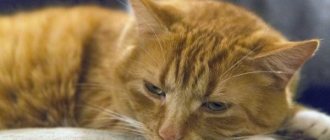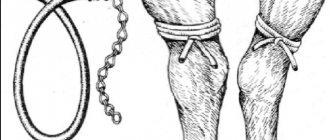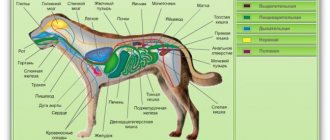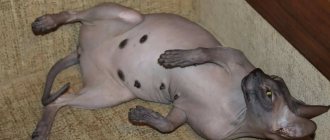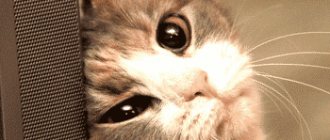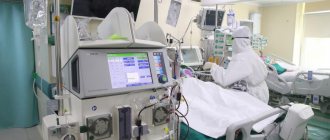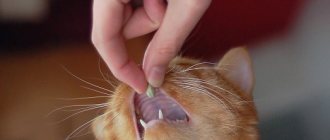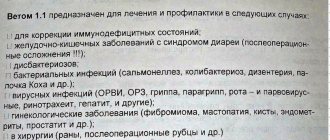Types of bleeding
There are two types of bleeding - unilateral and bilateral. This is an important point to pay attention to when diagnosing the disease.
Unilateral
In case of unilateral bleeding (from one nostril), the animal must be examined by a veterinarian. The most common causes of this are foreign bodies in the nose, trauma and tumors.
Bilateral
Bilateral bleeding (from both nostrils) may indicate an infectious disease.
What to do if your cat has a nosebleed
First aid for a cat with a nosebleed
So, the cat has blood coming out of its nose. If a runny nose initially occurs and streaks of blood appear in the mucus, this condition is most likely not critical, although it also requires certain actions (more about this in the article “What to do when a cat sneezes and has snot?”).
The release of drops, and even more so a trickle of blood, can seriously frighten the owner. What to do if your cat has a bleeding nose? First of all, put off panic. The owner's anxiety can agitate the pet, and this will lead to increased blood pressure and, as a result, increased bleeding.
Try to calm down: now the health of your beloved animal depends on your composure. Provide your pet with silence and a calm environment.
If moderate to severe nosebleeds develop, it is better to adhere to the following algorithm of actions:
- Apply something cold to the bridge of your nose, such as an ice pack or something wrapped in a cloth from the freezer. This must be done in such a way as not to prevent the animal from breathing freely.
- Find out where the nearest veterinary clinic equipped with a rhinoscope is located. If there is no one nearby, then go to any other one or call a veterinarian at home.
- While you are waiting for a doctor's examination, if possible, carefully examine the animal yourself - its face and mouth. Remember what medications you gave the cat, whether there was access to the street, etc. If the animal feels unwell, has pale mucous membranes and rapid breathing, and the bleeding continues, then the clinic can see you without a queue.
Causes of bleeding
The animal's nasal cavity contains blood vessels and nerves. Most often, the reason why a cat's nose is bleeding is injuries to small vessels due to mechanical damage or inflammation of the mucous membrane. However, the reasons may be more serious.
Injuries
Blood in a cat's stool: causes and treatment
This refers to damage due to a piercing blow, for example, after contact with a plant that has a hard spine, a fight with other animals, or an accident - a blow, a fall, a car accident, etc.
Foreign bodies
Sometimes small objects get into the animal’s nasal cavity - grains, pieces of stems or branches, etc., which injure its outer shell.
Periodontal diseases
Another common cause of bleeding is inflammation of the oral cavity, for example, abscesses (purulent inflammation of tissue) of the roots of the teeth. Diseases are a serious obstacle to the normal functioning of the nasal mucosa, which in turn can lead to dryness and bleeding.
Tumor
Tumors in the nasal cavity most often appear in older animals. The presence of this problem can be determined by the shape of the cat's face. As a rule, neoplasms make it less symmetrical, and sometimes even deform it.
Note! Swelling, changes in the integrity and color of the skin of the nose, lacrimation and changes in the size of one of the eyeballs may occur.
What could be the reasons
Infections
The cause of nasal discharge, including bleeding, can be bacterial, viral respiratory diseases, or rhinitis. If your cat is bleeding from the eyes and nose, it is necessary to undergo an examination at a veterinary clinic.
Impaired blood supply
Bleeding can also be caused by a blood clotting disorder, a function for which platelets are responsible. If their deficiency occurs, the blood acquires a thinner consistency, which leads to bleeding.
Signs of a serious illness
Experts identify quite a few diseases that provoke poor blood clotting. In case of illness, the animal may also experience other symptoms - for example, red spots on the ears and gums, pale gums. Also, the cat may not want to get out of bed in the morning and will lie all day due to loss of strength and lethargy.
Blood in a cat from the anus, in a cat and a kitten
Reduced blood clotting in cats can occur due to diseases such as viral leukemia and viral immunodeficiency. It can be caused by side effects of anti-inflammatory drugs. Another common reason is as a result of pathologies of the systems responsible for blood clotting, for example, disseminated intravascular coagulation syndrome, liver failure, hemophilia.
Note! Severe purulent discharge with blood from the eyes or nose may also indicate the presence of worms.
Blood when sneezing
Bleeding when sneezing can be caused by inflammation or irritation of the nasal mucosa. As a result of prolonged and severe sneezing, heavy bleeding may occur, as well as a slowdown in natural blood clotting.
Blood when sneezing
If your pet does not stop sneezing blood for a long time (more than 1-2 days), you should urgently contact a veterinarian. At home, it is very difficult to determine the cause of the disease, much less help the animal. First aid can be effective depending on the situation, but if the cause of the bleeding is unclear, then doing it on your own can even harm the cat.
Note! If cuts and scratches are noticed in the nose, they will need to be treated. For this, it is best to use an antiseptic without a strong odor, a spray for cats, or a special wound-healing ointment.
Flux or periodontal disease
If you have symptoms of periodontal disease or gumboil in case of bleeding in the nasal cavity, you should contact your veterinarian. The pet's nasal or oral cavity may become swollen, which will become a serious obstacle to the animal's normal functioning.
Unpleasant smell
Bloody nasal discharge in animals may be accompanied by an unpleasant odor. The reasons may be different, for example, an unpleasant odor may occur as a result of foreign bodies entering the nose. If a cat sneezes with blood, the nasal discharge is green and has an unpleasant odor, then most likely the pet has picked up some kind of virus. These same symptoms appear in leukemia, so they should not be ignored.
Important! Diagnosis and treatment should be carried out exclusively by a specialist - inadequate assistance will only do harm.
Labored breathing
Difficulty breathing accompanied by bleeding may indicate swelling in the nasal cavity. These can be either malignant neoplasms or swelling as a result of inflammation or an allergic reaction. The cause may also be a foreign body that has entered the nasal cavity.
The kitten has lost its appetite and is having difficulty breathing
Loss of appetite
Loss of appetite, general weakness and lethargy are most often observed in infectious diseases. Sometimes an animal may refuse to eat due to pain in the mouth and nose while chewing. In this case, the pet should be checked for tumors in both cavities.
Causes and symptoms
Sneezing and discharge in an animal can be caused by infectious and non-infectious causes. Depending on this, you need to build treatment.
Colds and hypothermia
Cats have a very high immunity, and colds - so frequent and even commonplace for humans - are rather an exception to the rule for an animal. Colds and runny noses are more common in homeless cats during periods of cold and rain. Colds occur for several reasons:
- The room is too damp, drafty.
- High humidity.
- Lack of vitamins, poor nutrition.
- Sudden temperature changes.
- The animal is hypothermic or wet (this can happen if the cat, for example, is not dried well after bathing).
Symptoms that will indicate a cold:
- Dry or, conversely, hot nose.
- Hair loss or dullness.
- Great lethargy.
- The cat sleeps for a long time or gets very scared of something that didn’t bother her before.
- Weakness (the animal stands well on its feet, but is apathetic), increased fatigue.
- Decreased appetite.
With a cold, breathing becomes difficult, the snot is clear and not viscous. The cat sneezes and coughs heavily, and the eyes may water. If discharge sticks to the muzzle or crusts appear, this means that the disease is becoming serious and may progress to the pathological stage.
An animal can breathe through its mouth to facilitate the process of obtaining oxygen, but if this happens constantly and the nose is not involved, you should immediately consult a doctor.
Allergy
If the animal sneezes, tries to constantly rub its eyes and nose, and discharge of a transparent texture appears from the eyes, most likely, we are talking about an allergic rhinitis. The snot in this case is liquid, transparent in color (odorless), and may be accompanied by swelling and dermatitis. Breathing is impaired and itching is likely.
REFERENCE
Cats can develop allergies to a certain product. After consultation with a veterinarian and tests, he will have to be ruled out. There may be allergies to medications, pollen, house plants, and even household items. Most often, the animal reacts to the irritant after several hours, but symptoms can appear several days after encountering the allergen.
Fungi and bacteria
Human ARVI, most often, is not transmitted to cats, but if the disease is caused by certain fungi and bacteria, then both the owner and the pet can become infected with a runny nose.
A bacterial infection is indicated by:
- unpleasant smell of discharge and its yellow-green color;
- accumulation of pus in the corners of the eyes or over the entire surface;
- snot from the nose and tears from the eyes;
- constant sneezing and coughing;
- the animal constantly swallows, this is due to the fact that mucus accumulates in the nasopharynx;
- body temperature rises;
- loss of appetite;
- dehydration;
- prolapse of the third eyelid.
Fungal infections overwhelm animals with weak immunity and often the runny nose becomes chronic. An indicator of a bacterial infection is a crust in the nose, which makes breathing very difficult and snot comes out of the nose.
Important! If the polyps have grown, the animal's face will become deformed. This is dangerous because the inflammation spreads to the brain; the symptoms of this are seizures.
Video about runny nose in cats:
Foreign bodies
Coughing and sneezing may be caused by a cat swallowing a foreign object in its intestines or esophagus. If this happens, the symptoms will be as follows:
- Profuse salivation.
- If a foreign body is in the throat, then coughing and wheezing appear, the tongue turns blue, and the cat may lose consciousness.
- Constant swallowing.
- Vomiting and belching.
- Complete lack of appetite.
- Bloating.
- Lethargy, apathy, drowsiness.
- Diarrhea, constipation.
- Symptoms of general intoxication.
Congenital pathologies
A runny nose can result from birth defects and injuries. For example, a “cleft palate,” that is, disturbances in the structure of the upper jaw and nasal bones, will cause the cat difficulty breathing and wheezing. Injuries to the jaw or head can result in a cleft palate. The bones can become displaced, and all this together will give the animal a chronic runny nose.
Important! If rhinitis does not go away for a long time or occurs periodically, be sure to contact your veterinarian.
With such pathologies, the discharge does not have an unpleasant odor and most often does not affect the general condition of the cat (if the injury is cured and is not life-threatening). To clarify the causes of chronic runny nose, you should contact your veterinarian. He will identify the pathology and tell you whether it is possible to treat it or eliminate the symptoms.
Diagnosis and treatment
The cat's hind legs have failed: causes and treatment
Only a veterinarian can determine the cause of bleeding in a cat, based on the results of a comprehensive examination of the animal.
When your nose bleeds
The “severity” of therapy depends directly on the underlying underlying cause. In case of an infectious disease (cold), the animal will have to undergo a course of treatment with antibiotics and antimicrobials. If the cause of bleeding is a severe oral disease or a tumor in the nasal cavity, then surgery will most likely be required.
If the diagnosis does not reveal any serious pathologies, then the approach to therapy is greatly simplified. In this case, you should apply cold to the pet's nose, and also use vasoconstrictor medications that can help stop the bleeding.
How to properly treat a cat
When he sneezes blood
Before contacting a doctor, the owner should carefully monitor the cat's behavior. If sneezing is not frequent, mucus is released from the nose along with blood, the animal’s breathing is difficult, and swelling around the eyes begins to appear, then the kitten is probably suffering from allergies. In this situation, the only way out is to stop the pet's contact with allergens.
In case of increased body temperature, apathy and weakness, cough accompanied by nasal discharge, the animal should be checked for the presence of an infectious disease. As already mentioned, antibiotics are prescribed to animals for infections.
Important! If tumors are detected, a biopsy is performed and the feasibility of surgery is assessed.
If bleeding is caused by complex injuries and deep penetration of a foreign object into the body, then most often they resort to surgical methods.
Prevention is better than any cure. You should not bring the animal to a painful state; the problem should be stopped in the bud. Your pet should be taken to the veterinarian at least once a quarter for preventative purposes. A professional doctor will be able to promptly detect signs of a dangerous pathology that threatens the cat’s health.
Treatment
Since a runny nose often becomes only an indicator of a viral infection or other inflammation in the body, it will be necessary to treat not so much it as the root cause. It is not always possible to independently find out the true source of the disease. Therefore, it is very important to consult a veterinarian, conduct a diagnosis and follow the treatment plan.
It will be very difficult to cure a stray cat from a runny nose if he is not provided with comfortable conditions: warmth, food, vitamins and scheduled medications.
Useful video on how to put drops in a cat's nose:
Colds and rhinitis
If your cat's cold cannot be treated at home, then you need to seek help from a veterinarian. The clinic will examine the cat and prescribe the necessary medications. It is not recommended to use medications without a prescription from a specialist. Typically treatment includes:
- Taking antipyretics if the temperature persists.
- Expectorants.
- Antibiotics.
- Vitamins.
- Droppers (to avoid dehydration).
- Maxidin. Drop into the nose to stimulate the immune system.
- Anandin. Antiviral and immune system stimulant.
- Naphthyzin together with Dioxidine. Nasal rinsing.
- Galazolin. Drops to ease breathing.
One drop of the drug is instilled into each nostril. The course is from five days to a week. You can rinse your nose with zinc sulfate (2%), boric acid (3%), a mixture of Methanol and fish oil.
Other means: “Maksidin”, “Derinat”.
Important! Never use “human” drops, they can aggravate the situation and cause irritation of the mucous membrane.
Allergic runny nose
Irritation in animals is caused by food and non-food allergens. The most common of them:
- Beef or pork.
- Chicken, chicken eggs.
- Cow's milk.
- Corn, wheat (other cereal grains).
- Potato.
- Carrot.
- Dust.
- Mold.
- Hygiene products, household chemicals.
- Irritant from a flea collar.
To cure an allergy, you need to accurately and in detail describe the symptoms to the doctor; it is advisable to note what exactly the cat reacts to and for how long. They do a blood test and scraping. Antihistamines and corticosteroids are most often used for treatment.
The house needs to be treated with insecticides, and the animal must be isolated from the allergen that causes the reaction. If you cannot immediately find out what exactly is causing the disorder, you must remove as much as possible all household chemicals, medications, cosmetics, etc. The room must be cleaned and ventilated frequently.
If the allergy is accompanied by itching, the doctor will prescribe a special ointment, shampoo or gel. Sometimes steroid hormones and immunotherapy are prescribed (a small amount of the allergen is injected into the blood so that the body gets used to it).
If you have an eating disorder, you need to follow a diet. For example, use hypoallergenic food. When the symptoms go away, the previous foods are returned to the diet, checking the animal’s reaction. If the runny nose recurs, food allergens should be categorically removed from the animal’s food forever.
Viral runny nose
Among viral infections, rhinotracheitis, calicivirosis, mycoplasmosis, chlamydia and other infections cause a runny nose. And although they differ, the treatment regimen is approximately the same for everyone. The main thing is to contact specialists in time. You cannot cure a viral infection on your own; only a veterinarian can prescribe the exact dosage and duration.
Serum or globulin is used to create immunity - the drug VITAFEL, vitamins and probiotics, replacement therapy.
Antibiotics are required. They are drunk for at least five days, most often from a week to ten days, one to three times a day.
Treatment at home
For treatment at home, nasal drops are used, for example, children's nasal drops - one in each nostril daily. You can rinse your nose with a hypotonic solution: a teaspoon of sea salt in warm water (half a glass). The mucous membrane is also washed with a solution of tannin (0.5%), soda (1% solution). Streptocide powder is blown into the nasal cavity or two drops of ecmonovocillin are dripped into each nostril (it is diluted with saline 1:2).
From folk remedies, rinsing with beet juice is suitable: 1 part juice to 3 parts water. Aloe juice from the cut is collected into a pipette and dripped for three days. To rinse, you can use boric acid (draw the liquid into a syringe without a needle, drop it into the nostril).
You can do inhalation: take a bowl of hot water, drop eucalyptus or other oil into it, and place the container near the animal.
